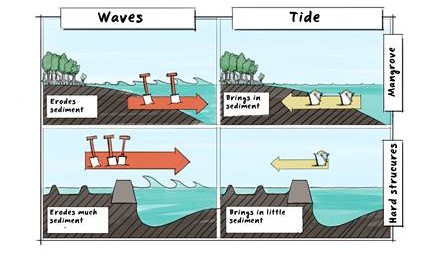
Mangrove-mud coasts; a muddy story
-
Coastal wetland conservation
In my previous blogs, we discussed that a healthy mangrove-mud coast is dynamic, and how these dynamics are controlled by the tide and the waves. In a healthy coastal system, these processes, which bring sediment towards the coast and take the sediments away, are more or less balanced.
We also suspected that thoughtless land-use, and in particular the massive construction of fish/shrimp ponds, may be the cause of the large amounts of erosion of mangrove-mud coasts.
But why is the building of fish/shrimp ponds so devastating? We need to understand this, if we want to design methods to reverse these erosion processes. Have a look at the cartoon below. The upper two drawings show how the tide and waves carry sediment to and from a healthy mangrove-mud coast. The two drawings below show what happens when fish/shrimp ponds are built. These ponds are protected from the sea by bunds, which are small dams often made of locally available mud, and sometimes protected with cloth or so.

From a hydrodynamic point of view, these soft mud-bunds form a hard structure in the coast. Waves reflect against these structures. As a result, the wave height in front of the bund increases by 50 – 100%. The erosive forces, induced by the waves, then become 2 – 4 times larger. Hence, more sediment is removed from the coastline.
But the tide is also affected. The presence of a bund reduces the amount of water which can flow towards the coast. Thus less sediment is carried to the shore, and sedimentation decreases. If more sediment is eroded by the waves, and less sediment is deposited by the tide, then the coast must retreat.
The erosion process is further aggravated because as the bunds interfere with the waves and the tides, the mudflat in the foreshore is also subject to higher waves and less sedimentation. The foreshore also erodes, becoming deeper in front of the bunds. Then higher waves, generated further offshore, can penetrate further on the mudflat, eroding it even further. This snowball effect is really devastating, destabilizing the entire mud-coast. Massive erosion is the result.
